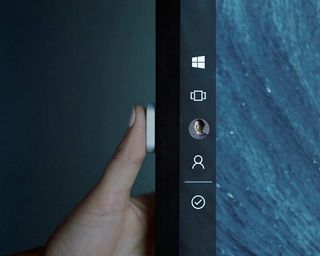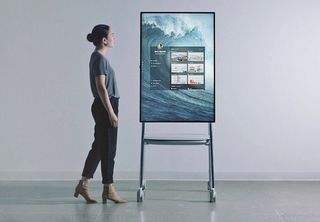Microsoft's Surface Hub 2 sports a 4K+ display and gravity-defying hinge
Rotating on a new hinge, the Surface Hub 2 is all about teamwork and collaborating.

In March, Microsoft gave a surprise preannouncement for the Surface Hub 2. The news was little more than a heads-up that refreshed hardware was planned, but more info was expected during "first half of this year."
Today is that day. Microsoft officially gave us the first preview of Surface Hub 2, and while there are still many details to be determined later this year, the video revealing the collaborative office PC is impressive.
The all new Surface Hub 2
The Microsoft Surface Hub 2 features a 50.5-inch "more than 4K" display with a familiar 3:2 aspect ratio. There is also a 4K video camera, built-in speakers, a new Surface Pen (more like a marker), far-field microphone array, and a near bezel-less screen.
The secret mojo though is that the new Surface Hub 2 can now rotate on an ingenious new hinge that lets users quickly switch the giant computer from landscape to portrait orientations. The large Surface can be mounted to a wall or on a new roller cart to make it more mobile.
Companies with deep pockets can splurge for two Surface Hub 2's placed side by side in landscape, or up to four Surface Hub 2's mounted adjacently in portrait mode. The PCs can then operate independently or together.
The Surface Hub 2 also features a thumbprint login system for Windows Hello, and in a new twist, the OS lets two users simultaneously log into the PC to share information in real time between accounts.

Windows 10 PCs and those using Microsoft Teams on any device (iOS, Android, or Windows) can interact with Surface Hub 2 directly and in "dynamic collaboration" using apps like OneNote, Teams, and Whiteboard in the office or across the world.
Get the Windows Central Newsletter
All the latest news, reviews, and guides for Windows and Xbox diehards.
The other modification from the original Surface Hub is there is now only one size available versus the initial choice between 55-inch and 84-inch. Microsoft gave us the following rationale for the change:
Microsoft believes customers investing in collaborative computing solutions at-scale are looking for light-weight, flexible platforms that can meet the needs of a wide variety of spaces across their organization. Deploying custom solutions in a small number of rooms is extremely expensive and does not serve most of the population within a given office, let-alone company-wide. Surface Hub 2's modular product design allows for a much more affordable and dynamic solution that can scale from a personal office all the way up to a large 4-screen collaboration wall.
Early testing with select Microsoft partners for Surface Hub 2 will begin later this year, and general purchasing and shipments should start in 2019.
Pricing has not been determined, but Microsoft tells us it is in line with "similar devices" (the last-gen 55-inch Surface Hub costs $8,999, so it won't likely be cheap).
What we don't know about Surface Hub 2

While there is much more to talk about with Surface Hub 2, especially with that new sizzler promo, there is plenty we do not know, including:
- Exact cost and local availability.
- If there is an internal battery for when mobile (on a cart).
- If the 4K camera will be sold separately.
- Processor, ports, and full specifications.
Those details are coming, and we expect a hands-on experience soon with Surface Hub 2.
First glimpse of Windows Core OS?

Windows Central Senior Writer Zac Bowden noted in February that Microsoft "is building an army of devices that are designed to work together" focusing on "collaboration, productivity, and 3D/Mixed Reality" with callouts to Surface Hub 2, HoloLens 2, and the rumored "Andromeda" foldable PC
Today's announcement from Microsoft seems to fall in line with that reporting.
Looking more closely at the Surface Hub 2 video the OS is a variant of Windows 10. We have long reported that C-shell and Windows Core OS would ship with Surface Hub 2 (codenamed "Aruba"; see also "Polaris") and we still believe that is the case (especially with the dual-login feature and general UI changes).
When asked, Microsoft would only say that the OS seen here is "built from Windows 10 with a focus on a collaborative environment." This is likely how Microsoft will publicly talk about Windows Core OS versus announcing something new and causing confusion.
Also spotted in the Surface Hub 2 is dynamic wallpaper that moves in the background, another feature we have heard is coming to Windows Core OS.
Microsoft informs us that the original Surface Hub will get "the same great features and updates that were built for Surface Hub 2" through a software update for current Hub customers.
Who is Surface Hub 2 for?

Microsoft sees the future of the office as collaboration. Speculating that future Surface devices – even unannounced ones – will participate in this new mode of working is not a stretch.
More to the point of Surface Hub 2, Microsoft references that millennials and Generation Z are quickly becoming the dominant age group in the workforce. These users are "digitally native" and expect to work together, while also being creative on the job. With Surface Hub 2, Microsoft is simply responding to that by asking "how can we help people be creative ... and share their ideas."
Surface Hub 2 lets users create and share while also allowing the device to exist in meeting rooms, huddle spaces, or even private offices. With a single thumbprint login, the OS pulls in your documents and information for the cloud for a glimpse of what "edge computing" actually means.
Why announce Surface Hub 2 now?

Businesses and institutions that plan long term around information technology (IT) and hardware need a long on-ramp. Microsoft knows this process can take some companies up to 18 months to switch over after initial planning and budgeting, making the enterprise space vastly different from the immediacy of the consumer market.
Presumably, companies will start to plan out for Surface Hub 2 – including the high price tag for budgets – now with anticipation to roll it out in 2019 and 2020. Microsoft is also giving companies a nod that they should likely pass on buying a new Surface Hub, or any other competitor in the market, as something better is on the way.
The original Surface Hub was one of Microsoft's most successful businesses Surfaces to date with more than 5,000 customers across 25 markets, according to the company. Microsoft looks to continue that momentum with Surface Hub 2 and working closely with current customers first.
We can assume Microsoft will share more about Surface Hub 2 in the coming months. The Microsoft Ignite conference is in September, making it an excellent opportunity for a more extensive public reveal, but Microsoft has not yet committed to any such plans.

Daniel Rubino is the Editor-in-chief of Windows Central. He is also the head reviewer, podcast co-host, and analyst. He has been covering Microsoft since 2007, when this site was called WMExperts (and later Windows Phone Central). His interests include Windows, laptops, next-gen computing, and watches. He has been reviewing laptops since 2015 and is particularly fond of 2-in-1 convertibles, ARM processors, new form factors, and thin-and-light PCs. Before all this tech stuff, he worked on a Ph.D. in linguistics, watched people sleep (for medical purposes!), and ran the projectors at movie theaters because it was fun.
